8.7 Setting Up Login Profiles
Login profiles let you save the information from a user's individual login. When the user selects this profile during login, the profile automatically sets up the login information you specify, such as the user's name, server, tree, context, login script, and other applicable information so that the user does not need to enter this information.
Login profiles are especially useful for users who log in from multiple places. Users can have separate profiles for the office, home, laptop, or any other workstation they use. This simplifies the login process so that users don’t need to remember their login information for each workstation. Using multiple login profiles also gives you control over what users can access from each workstation.
System Login Profiles and User Login Profiles
The Client supports “system login profiles”, which are created and managed by an administrator. System login profiles allow an administrator to provide the defaults for login even to new users who have never logged on from the current Windows machine. System login profiles may also be created by an administrator using the Client Install Manager (NCIMAN.EXE) so that they will be created automatically during the Client installation. For more information, see Section 8.7.2, Creating a System Login Profile for Use on Multiple Workstations".
The Client also supports "user login profiles", which can be created and managed by the user. In many cases, a user login profile is created automatically for the user in response to the Save profile after successful login setting in a system login profile. The user can also directly create and edit their user login profiles from the Login Profile Administration option in the Client Tray menu. For more information, see Managing Your Login Profiles
in the Client for Open Enterprise Server User Guide.
When a login profile exists both as a system login profile and also as a user login profile, the user login profile takes precedence so that any user-specific details necessary for the user to successfully login will be used. For example, the administrator may have created a system login profile named "Default" that specifies the eDirectory tree name and a specific default eDirectory context. But the user may need to specify a more specific eDirectory context in order to successfully log on to eDirectory, different from the eDirectory context that the administrator specified in the system login profile.
The user's eDirectory context selection will be saved as part of a user login profile named "Default". Such that now a user login profile named "Default" exists for this user, in addition to the system login profile named "Default" created by the administrator. As the user login profile takes precedence, during future Client logins the eDirectory context and other login defaults will be correctly remembered for the user. As the user login profiles specific to this user, it will be loaded as soon as their username is entered into the "Username" field of the Client login.
If a user chooses to delete their user login profile, and a system login profile exists with the same name, the login profile will revert to the administrator-defined system login profile settings. Only an administrator can delete or change the properties of a system login profile. The user can only create and manage their own user login profile of the same name (which was initially based on the administrator defined system login profile), or the user can create their own additional login profiles completely independent of any system login profile.
You can edit system profiles (and only system profiles) on the System Login Profiles tab in the Client Properties dialog box (right-click the Client Tray icon in the notification area of the taskbar, click Client Properties, then click the System Login Profiles tab).
Figure 8-1 System Login Profiles
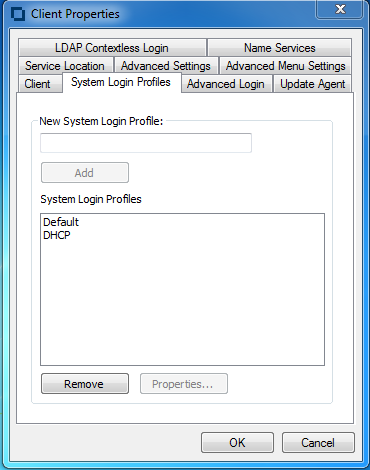
When you edit user profiles (right-click the Client Tray icon in the notification area of the taskbar, click User Administration for, then click Login Profile Administration), you will see both system profiles and user profiles in the list of profiles. Whether a profile name listed in the Login Profile Administration list happens to be a system login profile or user login profile should not be important. Both the Login Profile Administration list and the “Login Profile” selection list (if any) on the Client login dialog simply intends to present the list of selectable login profile names, regardless of whether they happen to be system login profiles or user login profiles.
Figure 8-2 User Login Profiles
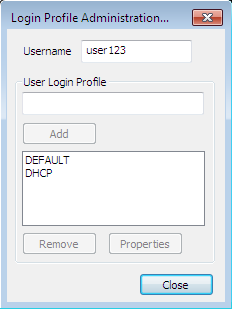
You can initiate editing any profile presented in the Login Profile Administration list regardless of whether it happens to be a system login profile or a user login profile. Editing a user login profile will modify the profile directly, whereas if the profile selected for editing happens to be a system profile, any changes made during editing will be saved as a user login profile.
Using Login Profiles During Login
When users log in using the Login dialog box, they can select the login profile they want to use from the Login Profile drop-down list. You can use the Advanced Login tab in the Client Properties dialog box to specify if the Login Profile drop-down list is available or not.
By default the Client displays the Login Profile list "automatically", which means that the Login Profile list is automatically enabled whenever there is more than one login profile the user might potentially be able to choose. If there is only one login profile available, then the Login Profile list will not be shown since no alternate login profile selection can be made.
Figure 8-3 Login Dialog Box with the “office” Login Profile Selected
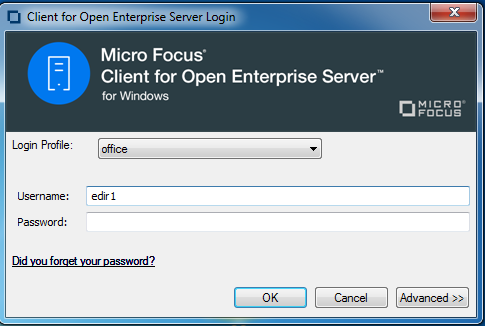
If you login with a system login profile which has the "Save profile on successful login" enabled, or if you explicitly attempt to edit the system login profile from the Login Profile Administration dialog, a user login profile is automatically created with the same name as the system login profile. During future logins or login profile editing actions, this user login profile will take precedence and be used or edited instead of the system login profile.
For information on creating and editing user login profiles, see Managing Your Login Profiles
in the Client for Open Enterprise Server User Guide.
8.7.1 Creating a System Login Profile
-
Right-click the Client Tray icon (
 ) in the notification area of the taskbar.
) in the notification area of the taskbar.
-
Click Client Properties, then click the System Login Profiles tab.
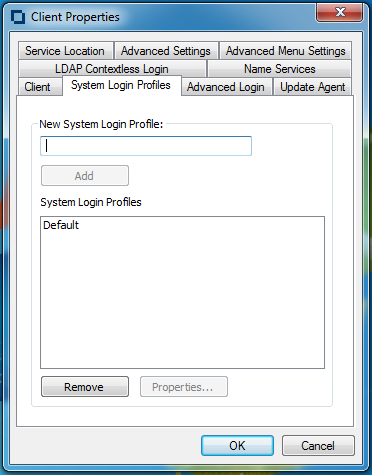
-
Type the name of the profile you want to add in the New System Login Profile text box, then click Add.
You can give a system login profile the same name as a user login profile, but be aware that during login if a user already has a user login profile with the name, the user login profile will be used because user profiles always supersede system profiles when they have the same name.
-
In the Login dialog box, specify the login information you want for this profile, such as a tree, context, and server.
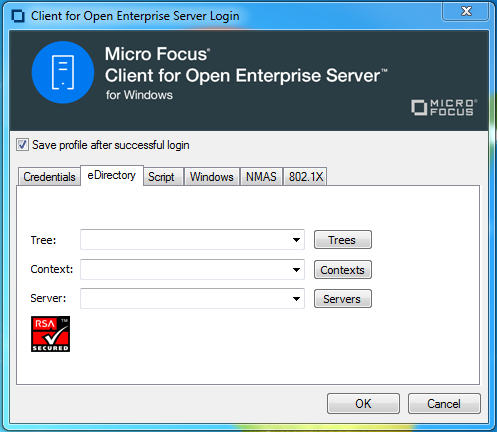
-
Click OK to close the Login dialog box, then click OK to close the Client Properties dialog box.
When a user logs in using the Login dialog box, he or she can select the system login profile from the Login Profile drop-down list.
Figure 8-4 Login Dialog Box with a System Login Profile Selected
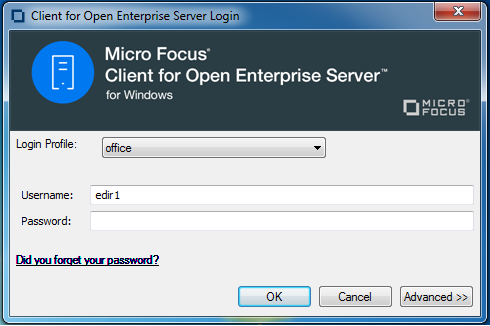
8.7.2 Creating a System Login Profile for Use on Multiple Workstations
Login Profiles are one of many settings that can be predefined by using a Client properties file that is applied during installation of the Client. For more information, see Creating the Client Properties File.
To create a system login profile that can be distributed by the Client Install Manager:
-
Start the Client Install Manager (nciman.exe), located in the C:\Micro Focus\Client for Open Enterprise Server 2 SP4 (IR3)\Admin folder.
-
In the Client for Windows Properties box, double-click Client to open the Client for Windows Properties dialog box, then click the System Login Profiles tabbed page.

-
Type the name of the profile you want to add in the New System Login Profile text box, then click Add.
To create the Default system profile, enter Default as the new profile name.
-
In the Login dialog box, specify the login information you want for this profile, such as the tree, context, and server.
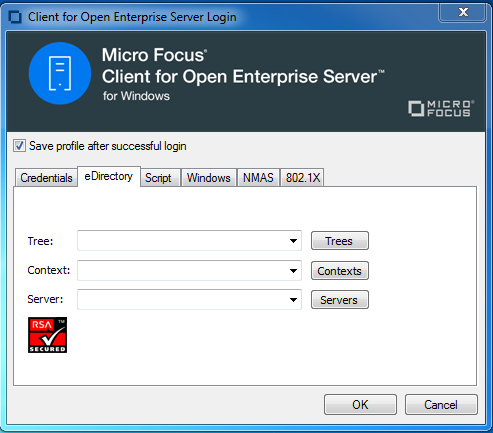
-
Click OK to close the Login dialog box, then click OK to close the Client Properties dialog box.
A parameter for the login profile you just created appears in the Parameter list in the Client Install Manager.
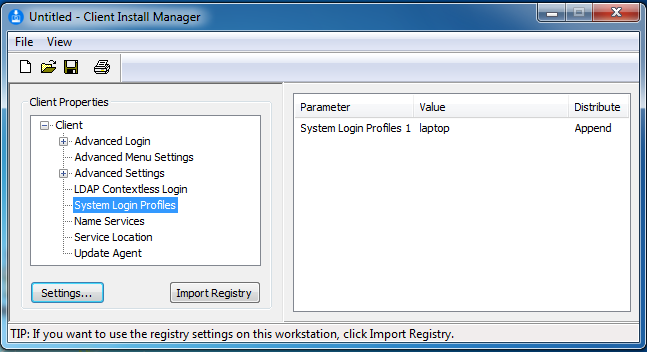
-
Right-click the system login profile parameter, then click Distribute (Append).
-
Select whether to append or replace any existing login profiles already on the workstations.
Appending an existing login profile merges the settings in this file with the settings that exist in the login profile already on a workstation. Replacing overwrites any existing login profile with this one.
By default, the new login profile item is automatically appended to any login profile that might exist on a workstation.
WARNING:If you right-click the login profile parameter and select Clear List and Distribute(Never), the login profile you just created is deleted.
-
Modify any other Client properties as needed.
For more information, see Creating the Client Properties File.
-
Click File > Save, then specify a name for the Client properties file.
You can use any filename (for example, workstation_properties.txt).
-
Copy this file to the root directory of the Client build (C:\Micro Focus\Client for Open Enterprise Server 2 SP4 (IR3).
This file can be specified as input to ACU, the Update Agent, or setup.exe during the next Client installation/upgrade. For more information on distribution methods, see Section 2.0, Advanced Installation Options.
8.7.3 Viewing or Editing a System Login Profile's Properties
-
Right-click the
 icon in the notification area of the taskbar.
icon in the notification area of the taskbar.
-
Click Client Properties, then click the System Login Profiles tabbed page.
-
I n the System Login Profiles list, select the name of a profile.
-
Click Properties.
-
In the Login dialog box, view or modify the login information you want for this profile, such as the user's name, server, and context.
-
Click OK to close the Login dialog box, then click OK to close the Client Properties dialog box.
8.7.4 Removing a System Login Profile
-
Right-click the
 icon in the notification area of the taskbar.
icon in the notification area of the taskbar.
-
Click Client Properties, then click the System Login Profiles tabbed page.
-
In the System Login Profiles list, select the name of the profile you want to remove.
-
Click Remove.
-
Click OK to close the Client Properties dialog box.
8.7.5 Enabling the Use of DHCP In a System Login Profile
If a DHCP server is set up on your network, the DHCP server can inform the Client of network-specific configuration information.
You can easily configure OES DHCP servers (NetWare 5 and later) to distribute this information to the clients. For more information, see the Novell DNS/DHCP Administration Guide for Linux or the Novell DNS/DHCP Administration Guide for NetWare.
Clients obtain configuration information from DHCP even when you statically configure the clients' IP addresses or when the DHCP server used to supply the information is different from the DHCP server supplying an IP address to the clients.
Unlike the Novell Client for Windows XP/2003, the use of information from DHCP options 85, 86, and 87 is not enabled through a DHCP Settings tab in the Client Properties dialog box. Using information from DHCP in the Client is enabled directly from the Tree:, Context:, and Server: fields in the login profile. You can enable use of DHCP information when creating a new profile or when editing an existing profile.
-
Right-click the
 icon in the notification area of the taskbar.
icon in the notification area of the taskbar.
-
Click Client Properties, then click the System Login Profiles tabbed page.
NOTE:Users can create their own DHCP profiles by using the Login Profile Administration option on the Client Tray menu. See
Enabling the Use of DHCP In a Personal Login Profile
in the Client for Windows User Guide for more information. -
Type the name of the profile you want to add (for example, Corporate) in the New System Login Profile text box, then click Add.
-
In the fields you want to be filled by DHCP, select <DHCP> from the drop-down menu.
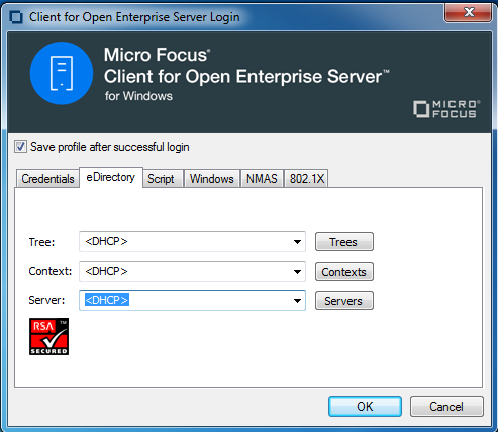
-
Click OK twice.
The next time a user opens the Login dialog box, the DHCP-enabled profile is available as an option on the Login Profile drop-down menu.
Select the DHCP-enabled profile from the Login Profile drop-down menu to automatically populate the fields that were given the <DHCP> option in Step 4 with whatever the DHCP server sends.
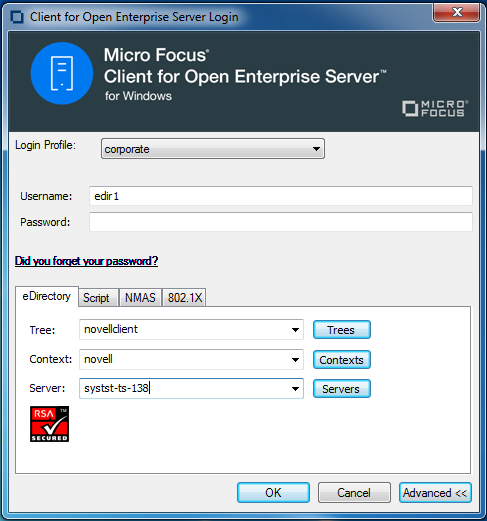
NOTE:When using the login profile to perform a login, users can overwrite the values displayed by DHCP, but the changes are in effect only for that specific login. If <DHCP> is chosen as an option in a login profile for Tree, Context, or Server, it cannot be removed by simply editing the field when logging in or by saving the profile on successful login. Any values entered in these fields during login are not saved when <DHCP> is enabled for that field. If users want to permanently change the values in that field, they must edit the login profile using either the System Profile Manager (System Login Profiles tab on the Client Properties dialog box) or the User Profile Manager (Login Profile Administration option on the Client Tray menu).